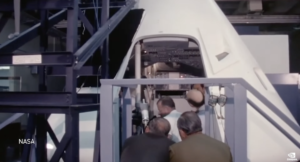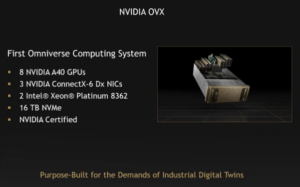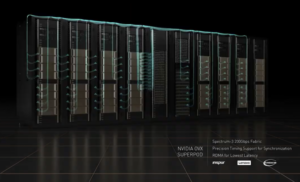

Tuesday at its GTC developer conference, Nvidia launched a new computing system for industrial digital twins, the Nvidia OVX.
Nvidia OVX was created for the purpose of running digital twin simulations within the Omniverse, Nvidia’s industrial operations metaverse that is “a real-time physically accurate world simulation and 3D design collaboration platform.”
“Just as we have DGX for AI, we now have OVX for Omniverse,” said Nvidia CEO Jensen Huang in his GTC keynote.
In fast-paced industries constrained by time, physical space, and computing limitations, digital twin technology is promising to transform operations through advanced designing, modeling, and testing capabilities.
“Physically accurate digital twins are the future of how we design and build,” said Bob Pette, vice president of Professional Visualization at Nvidia. “Digital twins will change how every industry and company plans. The OVX portfolio of systems will be able to power true, real-time, always-synchronous, industrial-scale digital twins across industries.”
Specifications
A first generation Omniverse OVX computing system is comprised of eight Nvidia A40 GPUs, three Nvidia ConnectX-6 Dx 200-Gbps NICs, dual Intel Ice Lake 8362 CPUs, 1TB system memory, and 16TB NVMe storage. The OVX computing system can be scaled from a single pod of eight OVX servers up to a SuperPOD of 32 OVX servers when connected with Spectrum-3 switch fabric. Multiple SuperPODS can also be deployed for larger simulation needs.
Capabilities
“OVX will enable designers, engineers, and planners to build physically accurate digital twins of buildings or create massive, true-to-reality simulated environments with precise time synchronization across physical and virtual worlds,” said Nvidia. With the ever-increasing complexity within industry, the testing and evaluation of intricate systems and processes that often operate simultaneously and autonomously can be challenging or sometimes impossible. Creating a digital twin of these systems, such as those in a factory or warehouse involving autonomous vehicles or robots, allows companies to digitally optimize operations for better efficiency or innovation before actual, real-world deployment of modifications or developments.
In his keynote address, Huang noted that because of the complexity of industrial systems, “the Omniverse software and computer need to be scalable, low latency and support precise time,” and since data centers process data in the lowest possible time, but not in precise time, the company wanted to create a “synchronous data center” with OVX. “Most importantly, the network and computers are synchronized using precision timing protocol and RDMA minimizes packet transfer latency,” Huang said.
Origins of Digital Twins
Also in his keynote address, Huang gave the example of the famous Apollo 13 mission where astronauts’ lives hung in the balance 136,000 miles from home after an oxygen tank exploded due to faulty wiring. Back on Earth, NASA engineers used a physical replica of the mission’s Odyssey spacecraft to test procedures for power-cycling and oxygen preservation which ultimately enabled NASA to safely return the crew. Huang noted that disaster was averted thanks to the replica and accompanying mathematical modeling, and the prototypical digital twin concept was born. NASA later coined the term digital twin, defining it as “a living virtual representation of something physical.”

A screenshot from Huang’s GTC keynote showing NASA engineers working with a replica of the Odyssey spacecraft. Source: Nvidia
While not all digital twin applications are as thrilling as saving the lives of astronauts, companies today are finding similar value in creating digital twins in the Omniverse. In Germany, DB Netze, an infrastructure arm of the national rail holding company, Deutsche Bahn, “is building in Omniverse a digital twin of Germany’s national railway network to train systems for automatic train operation and enable AI-enhanced predictive analysis for unforeseen situations in railway operations,” according to Nvidia. DB Netze is optimistic about the greater outcomes a digital twin can facilitate.
“Using a photorealistic digital twin to train and test AI-enabled trains will help us develop more precise perception systems to optimally detect and react to incidents,” said Annika Hundertmark, head of railway digitization at DB Netze. “In our current project, Nvidia OVX will provide the scale, performance, and compute capabilities that we need to generate data for intensive machine learning development and operate these highly complex simulations and scenarios.”
First generation OVX systems have already been deployed at Nvidia and for some early customers, and a second-generation system is currently in development that will benefit from Spectrum-4, a 51.2 terabits-per-second, 100 billion transistor Ethernet switch meant to tune precision timing even further. The company says its Nvidia-Certified OVX system will be available through Inspur, Lenovo, and Supermicro later this year, along with enterprise-grade support and Omniverse software to be jointly provided by Nvidia and the OEM system builders. Customers can test the OVX system at one of Nvidia’s Launchpad locations worldwide.
To watch a replay of Tuesday’s GTC keynote, visit this link.
May 10, 2024
May 9, 2024
- Lightning AI Launches Its Studio Platform in AWS Marketplace
- Precisely Continues to Expand Reach and Capabilities for Data Enrichment and Geo Addressing
- Databricks Enhances Enterprise AI with RAG Applications and Improved Model Serving
- StarTree Extends Real-Time Analytics Capabilities for Observability and Anomaly Detection Use Cases
- Snowflake Unveils the Future of AI and Data at 6th Annual Data Cloud Summit
May 8, 2024
- IBM and SAP Announce New Generative AI Capabilities to Transform Business Processes
- Alteryx: Businesses Embrace Generative AI, but General Public Remains Wary
- Atlan’s Control Plane to Power Data & AI Governance Attracts $105M
- Cisco Unlocks AI-Powered Intelligence for Self-Hosted Observability
- Boomi Accelerates Enterprise Data Connectivity with Advanced API Management Acquisitions
- Elastic Security Labs Releases Guidance to Avoid LLM Risks and Abuses
- Neo4j Empowers Syracuse University with $250K Grant to Tackle Misinformation in 2024 Elections
- Cloudera Unveils New Flow Management and Streaming Operators at Red Hat Summit
- DataForge Open-Sources First Functional Data Programming Framework
May 7, 2024
- Datadog Launches IT Event Management to Enhance AIOps Capabilities
- Panasas Rebrands as VDURA: A New Chapter in Software-Defined Storage for AI Applications
- Niobium Secures $5.5M in Venture Financing to Commercialize FHE Accelerator Chip
- Oracle Code Assist Can Help Developers Build Applications Faster with AI
Most Read Features
Sorry. No data so far.
Most Read News In Brief
Sorry. No data so far.
Most Read This Just In
Sorry. No data so far.
Sponsored Partner Content
-
Get your Data AI Ready – Celebrate One Year of Deep Dish Data Virtual Series!
-
Supercharge Your Data Lake with Spark 3.3
-
Learn How to Build a Custom Chatbot Using a RAG Workflow in Minutes [Hands-on Demo]
-
Overcome ETL Bottlenecks with Metadata-driven Integration for the AI Era [Free Guide]
-
Gartner® Hype Cycle™ for Analytics and Business Intelligence 2023
-
The Art of Mastering Data Quality for AI and Analytics
Sponsored Whitepapers
Contributors
Featured Events
-
AI & Big Data Expo North America 2024
 June 5 - June 6Santa Clara CA United States
June 5 - June 6Santa Clara CA United States -
CDAO Canada Public Sector 2024
 June 18 - June 19
June 18 - June 19 -
AI Hardware & Edge AI Summit Europe
 June 18 - June 19London United Kingdom
June 18 - June 19London United Kingdom -
AI Hardware & Edge AI Summit 2024
 September 10 - September 12San Jose CA United States
September 10 - September 12San Jose CA United States -
CDAO Government 2024
 September 18 - September 19Washington DC United States
September 18 - September 19Washington DC United States




























